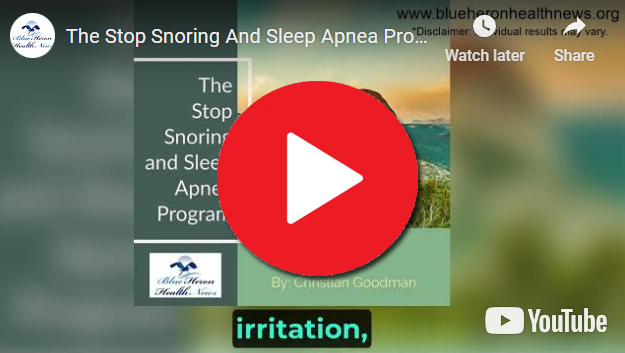
The Stop Snoring And Sleep Apnea Program™ a well-researched program created to help stop snoring and sleep apnea so that you can have a good night sleep. The techniques that you will learn from this program works immediately. It will only take you 3-7 minutes to perform these simple exercises that the author has recommended but the results that you will get will help you have a good night sleep as soon as tonight. Within a week, snoring will be a thing of the past.
What is the Brandt-Daroff exercise?
The Brandt-Daroff exercise is a set of physical movements used to treat benign paroxysmal positional vertigo (BPPV), a common cause of vertigo characterized by brief episodes of dizziness associated with changes in head position. The exercise helps to desensitize the inner ear’s balance system and encourages the repositioning of dislodged calcium carbonate crystals (otoconia) from the semicircular canals back to their proper location in the utricle.
How the Brandt-Daroff Exercise Works
The Brandt-Daroff exercise involves repeatedly moving the head into positions that trigger vertigo, with the goal of helping the brain adjust to the abnormal signals caused by the displaced otoconia. Over time, this process can help reduce or eliminate vertigo symptoms.
Performing the Brandt-Daroff Exercise
Here’s a step-by-step guide on how to perform the Brandt-Daroff exercise:
- Starting Position:
- Sit on the edge of a bed or a flat surface with your feet dangling and your head facing forward.
- First Movement:
- Quickly lie down on your side (let’s start with the left side) so that your head is at a 45-degree angle, facing up towards the ceiling. Hold this position for about 30 seconds or until any dizziness subsides.
- Return to Upright:
- Sit up quickly and remain in the sitting position for 30 seconds.
- Second Movement:
- Quickly lie down on the opposite side (the right side) so that your head is at a 45-degree angle, facing up towards the ceiling. Again, hold this position for 30 seconds or until the dizziness subsides.
- Return to Upright:
- Sit up again and stay in this position for 30 seconds.
Repetition and Duration
- Repetitions: A full session consists of five repetitions on each side (left and right), for a total of 10 repetitions per session.
- Frequency: The exercise should be performed three times a day until you are free from vertigo symptoms for at least 24 hours.
- Duration: Depending on the severity of the BPPV, the exercise may need to be continued for several days to weeks. It’s generally recommended to continue for a week after symptoms have resolved to ensure the condition is fully treated.
Key Points to Remember
- Consistency: Regular practice is crucial for the effectiveness of the Brandt-Daroff exercise. Skipping sessions can slow down the recovery process.
- Safety: If performing the exercise alone, ensure you are in a safe environment where you won’t be at risk of injury should you experience significant dizziness. Having someone nearby for support can be helpful, especially in the initial stages of treatment.
- Consultation with a Professional: It’s important to consult with a healthcare provider before starting the Brandt-Daroff exercise, especially if you have other health conditions or if you’re unsure about the diagnosis of BPPV.
Effectiveness and Considerations
The Brandt-Daroff exercise is particularly useful for patients who may not respond to other maneuvers like the Epley or Semont maneuvers or for those who prefer a simpler exercise they can perform at home. While it is less immediately effective compared to these other maneuvers, it can still provide significant relief over time.
Conclusion
The Brandt-Daroff exercise is a simple and effective home treatment for BPPV. By repeatedly moving into positions that can trigger vertigo, this exercise helps the brain adjust to the abnormal signals and can aid in the repositioning of the dislodged crystals within the inner ear. As with any treatment for vertigo, it’s important to consult with a healthcare provider to ensure it’s appropriate for your specific condition and to receive proper instruction on how to perform the exercises correctly.
How can physical therapy help with vertigo?
Physical therapy can play a significant role in the management and treatment of vertigo, a condition characterized by a sensation of spinning or dizziness. The type of physical therapy used depends on the underlying cause of vertigo. Here are some ways physical therapy can help:
1. Vestibular Rehabilitation Therapy (VRT)
Vestibular Rehabilitation Therapy is a specialized form of physical therapy aimed at improving balance and reducing problems related to dizziness and vertigo. VRT involves exercises designed to help the brain compensate for the mismatched signals it receives from the inner ear, visual, and proprioceptive systems.
- Habituation Exercises: These exercises are used when movements or visual stimuli consistently provoke vertigo or dizziness. The goal is to reduce the brain’s response to these stimuli through repeated exposure, thereby decreasing symptoms over time. For example, a patient might repeatedly practice moving their head in specific ways that trigger vertigo.
- Gaze Stabilization Exercises: These exercises help improve control of eye movements so that vision can remain clear during head movements. One common exercise is the “focus on a fixed point” technique, where patients move their heads side to side while keeping their eyes focused on a stationary object.
- Balance Training: Balance exercises aim to improve stability and coordination. They can include a range of activities such as standing on one leg, walking with turns, or using balance boards. These exercises challenge the vestibular system and help the brain learn to use alternative cues for balance.
2. Canalith Repositioning Maneuvers
These maneuvers are specific physical therapy techniques used to treat benign paroxysmal positional vertigo (BPPV), which occurs due to displaced calcium carbonate crystals (otoconia) in the semicircular canals of the inner ear. The goal is to move these crystals back to the utricle where they no longer cause symptoms.
- Epley Maneuver: This maneuver involves a series of specific head and body movements to guide the otoconia from the semicircular canals back to the utricle.
- Semont Maneuver (Liberatory Maneuver): Another series of rapid head and body movements designed to dislodge and reposition the otoconia.
- Brandt-Daroff Exercises: These exercises involve repeated movements that can help disperse the crystals. They are often used as a follow-up to the more immediate maneuvers like the Epley or Semont maneuvers.
3. Postural and Gait Training
For individuals experiencing vertigo that affects their balance and walking, physical therapists can provide training to improve posture and gait. This training focuses on:
- Improving Stability: Exercises that strengthen the muscles involved in maintaining posture and balance can help reduce the risk of falls.
- Coordination: Activities that enhance coordination can make movements smoother and more controlled, reducing dizziness.
- Adapting to New Balance Strategies: Patients learn to compensate for their vertigo by using visual or somatosensory cues to maintain balance.
4. Functional Movement Exercises
These exercises are tailored to help patients perform everyday activities more safely and comfortably. They might include:
- Sit-to-Stand Training: For improving the ability to stand up from a seated position without dizziness.
- Turning Techniques: Teaching safe ways to turn the head and body to minimize vertigo symptoms.
- Safe Ambulation: Techniques to safely walk, especially on uneven surfaces or in low light conditions.
5. Education and Self-Management
Physical therapists also educate patients on how to manage their symptoms effectively:
- Home Exercise Programs: Therapists often provide a series of exercises to be performed at home to continue progress between therapy sessions.
- Fall Prevention: Education on how to reduce the risk of falls, including modifications to the home environment and strategies for managing dizziness episodes.
6. Addressing Secondary Symptoms
Physical therapy can also address secondary symptoms associated with vertigo, such as neck stiffness or muscle tension, which can occur due to overuse of certain muscles to compensate for balance issues.
Conclusion
Physical therapy is a valuable treatment option for individuals experiencing vertigo, providing targeted exercises and maneuvers that can significantly reduce symptoms and improve quality of life. Through vestibular rehabilitation, canalith repositioning maneuvers, balance training, and patient education, physical therapists help patients regain control over their symptoms and enhance their daily functioning. It’s important for patients to work with a qualified physical therapist who can tailor a treatment plan to their specific condition and needs.

The Stop Snoring And Sleep Apnea Program™ a well-researched program created to help stop snoring and sleep apnea so that you can have a good night sleep. The techniques that you will learn from this program works immediately. It will only take you 3-7 minutes to perform these simple exercises that the author has recommended but the results that you will get will help you have a good night sleep as soon as tonight. Within a week, snoring will be a thing of the past.